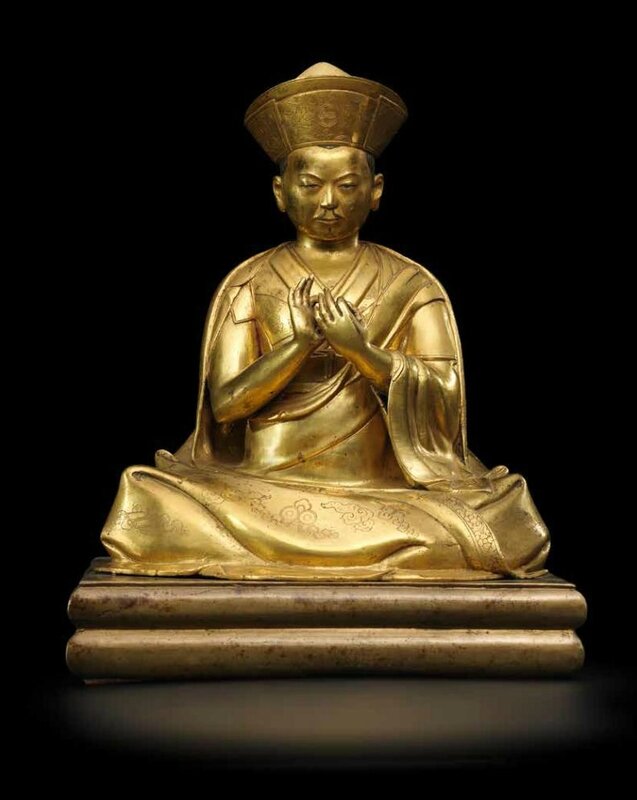A large gilt copper alloy figure of the Fourth Druk Desi of Bhutan, Tenzin Rabgye, Bhutan, late 17th-18th century
Lot 3248. A large gilt copper alloy figure of the Fourth Druk Desi of Bhutan, Tenzin Rabgye, Bhutan, late 17th-18th century. Estimate USD 150,000 ~ 200,000. Sold for US$ 391,500 (€362,432). Photo: Bonhams.
On a later brass base. 15 3/4 in. (40 cm) high
Himalayan Art Resources item no.2272
Note: The Drukpa Kagyu is the only order to wear this tall fan-shaped hat with a high peak that can be seen above its rim. Comparing the portrait to inscribed paintings of the Drukpa lineage, this figure's facial hair, hand gestures, and the absence of attributes flowering at his sides, singles him out as Tenzin Rabgye (1638-98), the fourth leader of the order after it established the sovereign nation of Bhutan. Compare with thangkas of him within the Rubin Museum of Art (HAR item nos.244 & 791) as well as murals in Bhutan (HAR item nos.82131 & 82072)
Among the Portraits of the Masters collection this appears to be one of the truest portraits observed from real life. It would suggest a date for the bronze not too far from its subject's lifetime, ending in 1698. He gazes with a magisterial countenance – stoic, steadfast, immovable. His hands progress the Dharma over Bhutan, reflecting a lifetime of building consensus among the kingdom's various ruling factions. The beautifully incised patterns with his hat and robe are large, precise, and broadly spaced, showing a restraint largely inconsistent with Tibetan styles of the period.
In the mid 17th-century, a schism occurred within the Drukpa Kagyu over rival claims for the legitimacy of its next incarnate leader. After his opposition secured the support of the King of Tsang and the Karma Kagyu, Shabdrung Ngawang Namgyel (1594-1651) migrated south. And while the Fifth Dalai Lama endeavored to unify Tibet, he sought to found a new sovereign state, the kingdom of Bhutan. There he established a dual system of government, with the Je Khenpo as the hierarch of religious affairs and the Druk Desi as the hierarch of administrative affairs.
Shabdrung lacked an heir and instead groomed Tenzin Rabgye for office, who was the son of Shabdrung's first wife who had since been betrothed to a ruling family in Western Bhutan in political alliance. Tenzin Rabgye was taught by the First, Second, and Third Druk Desis before being enthroned in 1680. He proved a most proficient ruler, who continued to implement Shabdrung's vision of a unified nation, cultivating diplomacy and patronage amongst the religious traditions within Bhutan, and a distinctive national identity.
Published: Portraits of the Masters, pp.198-9, no.49.
Published & Exhibited: Monasterios y Lamas del Tibet, p.182, no.132.
Provenance: Christie's, New York, 3 October 1990, lot 164.
Bonhams. PORTRAITS OF THE MASTERS, 108 Bronze Sculptures of the Tibetan Buddhist Lineages, New York

/https%3A%2F%2Fprofilepics.canalblog.com%2Fprofilepics%2F1%2F0%2F100183.jpg)
/https%3A%2F%2Fstorage.canalblog.com%2F03%2F02%2F119589%2F96711876_o.jpg)
/https%3A%2F%2Fstorage.canalblog.com%2F11%2F31%2F119589%2F94773502_o.jpg)
/https%3A%2F%2Fstorage.canalblog.com%2F20%2F83%2F119589%2F94772815_o.jpg)
/https%3A%2F%2Fstorage.canalblog.com%2F26%2F72%2F119589%2F75604929_o.jpg)
/https%3A%2F%2Fstorage.canalblog.com%2F59%2F60%2F119589%2F26458628_o.jpg)




/http%3A%2F%2Fstorage.canalblog.com%2F82%2F54%2F119589%2F30342725_o.jpg)
/http%3A%2F%2Fstorage.canalblog.com%2F28%2F46%2F119589%2F129031030_o.jpg)
/http%3A%2F%2Fstorage.canalblog.com%2F93%2F01%2F119589%2F129030904_o.jpg)
/http%3A%2F%2Fstorage.canalblog.com%2F29%2F91%2F119589%2F129030767_o.jpg)